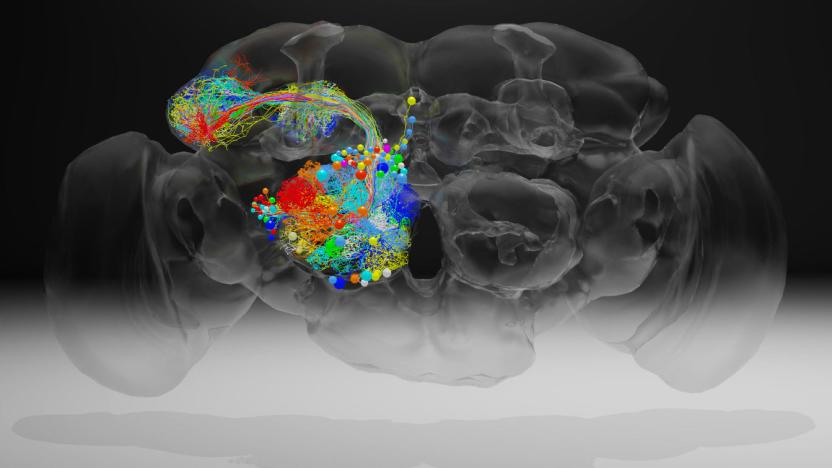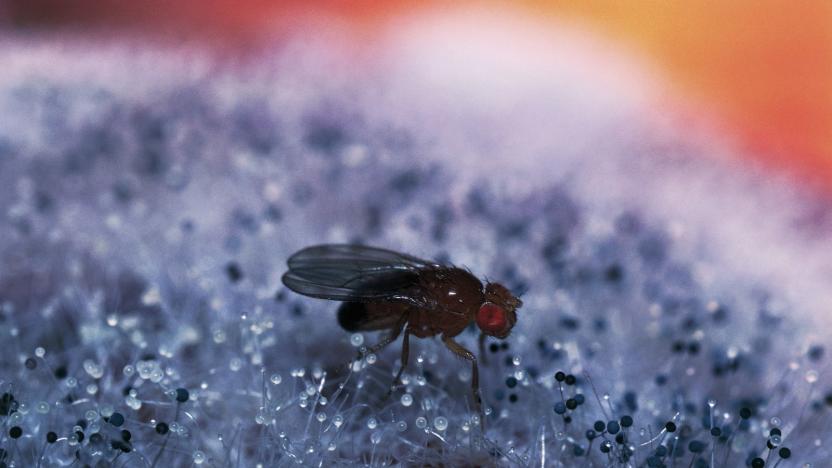FruitFly
Latest

Researchers capture high-resolution image of a complete fruit fly brain
Scientists have created a high-resolution image of a fruit fly brain that will let researchers trace the connections of neurons throughout the brain. A team at the Howard Hughes Medical Institute's Janelia Research Campus led the work, which was recently published in Cell. Davi Bock, the lead researcher on the project, said in a statement that this level of resolution hasn't been achieved before and it will allow scientists to better understand which neurons play a role in behaviors exhibited by fruit flies.

Malware creator charged for 13-year spying spree
You don't need an elaborate crime ring (or a government agency) to write malware that spies on others -- sometimes, just one person can be responsible. The US Department of Justice has charged Ohio resident Philip Durachinsky with 16 crimes for allegedly writing malware, nicknamed "Fruitfly," that gave him unfettered access to the PCs of "thousands" of individuals and institutions between 2003 and January 2017. Reportedly, he not only stole sensitive data to use for fraud and blackmail (such as logins, embarrassing chats and medical records) but took screenshots, logged keystrokes and spied on people through their webcams.

Researchers figure out trick to a fruit fly's acrobatic flight
If you've ever tried to swat a fruit fly out of the air, you know how crafty the little buggers can be at avoiding your swings. Turns out that not only are they incredibly agile, they're super efficient as well, using only 12 muscles (each controlled by a single neuron) to propel itself through the air. And, thanks to the efforts of a team at CalTech, we know why these flies are so nimble. It's all in the muscles.

Scientists 'pickle' and map a fly's brain for the first time
Sure, fully mapping the human brain is impressive, but think about it: our thinking muscle is pretty big. Not to be outdone by this week's advances from the Allen Institute, scientists from Japan's Tokai University have made a 3D model of the neurons in a fruit fly's brain. Think about that for a bit. Exactly; it's tiny. Okay, ready to read some more? Cool.

Researchers control fruit flies' hearts with a laser
Scientists have directly controlled animals before, but these approaches tend to either require surgery or only work with critters at certain stages in their lives. Researchers might have a more powerful technique in store, however: they've managed to control fruit flies' heartbeats through laser pulses. The approach relies on optogenetics, or modifying the genes of animals to produce materials that respond to light. In this case, the team tweaked flies' heart cells to produce light-sensitive proteins. After that, it was just a matter of zapping the hearts to make them beat on command, whether the flies were larvae or full-grown insects.

Genetic engineering lets fruit flies 'smell' light
Scientists in Germany have genetically engineered fruit fly larva to 'smell' blue light -- and apparently it smells like bananas! According to a paper published in Frontiers in Behavioral Neuroscience, researchers at Ruhr-Universitaet-Bochum were able to splice a gene for a light-activated protein into cells in the olfactory system. Depending on which cell was spliced, the larva perceived the blue light as smelling like anything from bananas to marzipan or even glue. The scientists used thin electrodes to detect the light-activated neurons, and it is hoped that research in this area will lead to similar procedures that don't harm living animals. Now that they've perfected modding Drosophila larvae, the scientists say they'd like to move on to adult fruit flies. Which is cool with us -- just as long as they don't repeat Seth Brundle's mistakes.

Mad scientists figure out how to write memories to brains, take over Earth
Call us crazy, but we're guessing one Gero Miesenböck of the University of Oxford has been watching just a wee bit too much Fringe. Gero here, along with a few of his over-anxious colleagues, has seemingly figured out a way to actually write memories onto a fruit fly's brain using only a laser pen and three-fourths of a Ouija board. We know what you're thinking, and we're thinking the same. But all terrifying thoughts aside, what if boffins could burn memories of hard lessons learned into our minds without us having to suffer through them first? You know, like upgrading to Snow Leopard.

Fruit fly flight simulator could smarten up robots
Wondering just how we mere mortals were going to even give a robot enough smarts to completely overtake our societies? Oddly enough, some of that artificial brain power could come from studying the way fruit flies, um, fly. A completely bizarre flight simulator at Caltech actually plays "scenes" that flys react to, and considering that the fly is constantly held, researchers can closely examine how the insect attempts to navigate away from lines, blobs and all manners of incoming obstacles. Those working with the installation suggest that these studies could one day help autonomous robots function better, potentially taking some of the load off of our human workforce. We know, you've got three bold letters and a question mark running through your noggin right now -- just hit the read link to see what it's all about.[Thanks, Dave]




